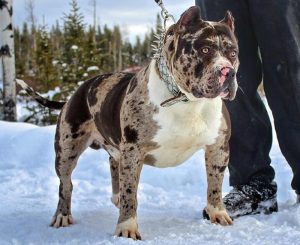Merle Bully
What is a Merle Bully?
A typical American Bully Merle is a kind of American Bully dog with a “merle” coat pattern. This coat pattern is distinguished by unevenly formed color patches that might appear black, blue, or red. The results of crossbreeding two Merle American Bulldogs are Cryptic Merles, which do not show the regular markings and display an alternate form than the usual Merle Bullies.
The patches are often darker than the dog’s primary coat color and may seem marbled or swirled. A genetic mutation in some American Bully dogs causes the merle coat pattern. It is important to note that not all American Bully breeders and organizations acknowledge the merle coat pattern, and some consider it a disqualifying trait.
The Fascinating History of the Merle Bully
The Merle Bully, with its captivating coat pattern, has a history as intriguing as its appearance. While the exact origins of the merle pattern remain a subject of debate among geneticists, it’s believed to have been present in various dog breeds for centuries. The pattern is a result of a specific genetic mutation that affects the pigmentation of the dog’s coat.
The American Bully itself, from which the Merle Bully variant arises, is a relatively new breed, having been developed in the 1980s and 1990s in the United States. Breeders aimed to create a companion dog that combined the best traits of several bully breeds, including the American Pit Bull Terrier and the American Staffordshire Terrier. The Merle Bully, with its unique coat pattern, emerged as a variant within this breed, capturing the hearts of many dog enthusiasts.
Understanding the Merle Coat in an American Bully
The striking mottled or marbled appearance of a Merle American Bully’s coat is the result of a genetic mutation affecting the merle gene, which plays a crucial role in the development of pigment in the skin and hair. This unique pattern is characterized by spots of color that are significantly deeper than the base coat color, creating a visually stunning contrast.
The intensity of the merle pattern can vary greatly among individual dogs, ranging from minor, irregularly shaped patches to large, distinct areas of color. In regions where the merle pattern is present, the coat may have a diluted, lighter hue, adding to the breed’s distinctive appearance.
While the merle gene can produce a variety of coat colors and patterns, including black, blue, chocolate, red, and fawn, each adorned with merle markings, it’s important to note that this captivating coat pattern is not exclusive to American Bullies; it’s a beauty shared across various dog breeds.
What Eye Color Do Merle Bullies Usually Have?
American Merle Bullies may have two distinct colors in their eyes (heterochromia), or one or both eyes may be blue or partly blue. This is due to the merle gene’s influence on eye pigment production. Heterochromia is a genetic trait induced by various reasons, one of which is the existence of the merle gene. Not all Bully Merles with the merle gene will exhibit heterochromia or blue eyes, as this is a hereditary feature that varies from breed to breed. Some Bully Merles may have brown, amber, green, or hazel eyes or a mix of these colors.
What are Some of the Health Issues Merle Bullies Can Have?

Specific health concerns may be more common in American Merle Bullies due to how the gene affects pigment production. These health concerns may include the following:
Deafness:
The merle gene can cause a lack of pigment in the inner ear, leading to hearing loss or deafness in one or both ears. This is more common in American Bullies with a double dose of the merle gene, which can occur when both parents carry the gene.
Eye problems:
The merle gene can also affect pigment production in the eyes, which can lead to problems such as vision loss or abnormalities in the structure of the eye.
Skin problems:
Merle Bullies may be more prone to skin problems such as sunburn, skin cancer, and other skin conditions due to the dilution of pigment in the skin.
It is important to note that not all Merle Bullies will develop these health problems, and many individuals with the gene may live long healthy lives. However, it is important for owners of Merle Bullies to be aware of these potential health concerns and to work closely with a veterinarian to monitor for any potential problems.
Ethical Considerations in Breeding Merle American Bullies
The practice of breeding Merle American Bullies is steeped in both admiration for their unique beauty and concern for their health. The Merle gene, responsible for their distinct coat patterns, is a double-edged sword, offering aesthetic appeal on one side and potential health risks on the other. These risks, including serious conditions like deafness and blindness, are particularly pronounced in double Merle puppies, who inherit the gene from both parents.
Breeders find themselves navigating a delicate balance, where the desire to produce visually appealing dogs must be weighed against the ethical responsibility to prioritize the animals’ health and the breed’s overall integrity. This balance necessitates a deep understanding of the Merle gene’s implications and a commitment to ethical breeding practices that consider the long-term well-being of the dogs and the breed.
Navigating the Debate: Should Breeding of Merle American Bullies Continue?
The question of whether to continue breeding Merle American Bullies is a contentious one within the breeding community and beyond. The heart of this debate lies in the Merle gene’s duality: its ability to produce stunningly beautiful coats and its association with severe health issues.
The decision to breed Merle Bullies isn’t straightforward. It requires breeders to consider the genetic complexities and the potential for health problems, especially when there’s a risk of producing double Merles. The controversy underscores the need for informed decision-making in the breeding process, emphasizing research, ethical considerations, and a focus on health and well-being over aesthetics.
The ongoing debate serves as a reminder of the responsibilities breeders undertake and highlights the importance of education and awareness in making decisions that affect the lives of these beloved animals and the future of the breed.
What Can and Should Be Done to Stop American Bully Merles From Being Bred?
There are a few steps that can be taken to reduce the prevalence of the merle gene in American Bullies:
Responsible breeding:
One way to reduce the number of Bully Merles is to ensure that only dogs with a single copy of the gene are bred. This can help to minimize the risk of health problems associated with the merle gene, such as deafness and eye abnormalities.
Genetic testing:
Before breeding a Merle Bully, it may be helpful to have the dog genetically tested to determine whether it has a single or double copy of the gene. This can help breeders decide which dogs to breed and which to avoid.
Education:
Educating potential American Bully owners about the potential health risks associated with the merle gene can help to reduce demand for dogs with this gene.
Ultimately, the most effective way to stop Merle Bullies from being bred is to ensure that responsible breeding practices are followed and that potential owners are aware of the risks associated with this gene. This can help protect the health and well-being of American Bullies and ensure that they are bred responsibly and ethically.
Merle Bully Price
The allure of the Merle American Bully, with its distinctive coat patterns, has led to a surge in its demand and consequently, its price. However, determining the exact cost of a Merle Bully can be complex due to various influencing factors.
On average, a Merle Bully puppy can cost between $5,000 and $10,000. Yet, this price range can fluctuate based on:
- Bloodline: The lineage of the puppy plays a significant role. Were the puppy’s parents healthy and of a reputable lineage?
- Breeder Reputation: Always research a breeder’s history and reputation. A well-regarded breeder might command higher prices, but it’s essential to ensure you’re getting a healthy and well-bred dog.
- Geographical Location: The availability of Merle American Bullies varies across regions. In areas where they are scarce, prices might be higher.
- Dog Training: A well-trained puppy, especially in obedience and socialization, can fetch a higher price.
- Type and Appearance: Unique and intriguing merle patterns, especially those resulting from specific breeding practices, can drive up the cost.
As the breed’s popularity has soared, prices have also seen an upward trend. What once cost $2,500 might now be priced at $4,000-$5,000. For those seeking top-tier bloodlines, especially from renowned breeders, prices can even reach a staggering $20,000 to $30,000 or more.
However, a higher price doesn’t always equate to higher quality. It’s crucial to investigate if the breeder has produced any notable dogs, champions, or grand champions. While many average pups might be priced above $5,000, there are exceptional Merle Bullies from champion lineages available for less.
Remember, the initial cost of acquiring the puppy is just the beginning. Given the potential health concerns associated with the Merle gene, owners should be prepared for regular vet visits, specialized diets, and potential medical expenses. It’s essential to budget for these ongoing costs and ensure you’re making a well-informed decision.
While the Merle American Bully is undoubtedly a prized possession, prospective owners should prioritize the dog’s health and well-being and ensure they’re working with reputable breeders.
American Merle Bully Personality and Temperament
Like all breeds, American Bullies can vary in personality and temperament. However, American Bullies are generally known to be loyal, protective, and affectionate dogs. They are often described as having a “bully” personality, meaning they are confident, outgoing, and assertive.
American Bullies are generally good with children and make excellent family pets, but like all breeds, they should be socialized and trained properly to ensure that they are well-behaved and well-mannered.
It is important to note that several factors, including genetics, training, and socialization, can influence the personality and temperament of an American Bully. Therefore, it is important for potential owners to consider these factors when selecting a dog carefully and to work with a responsible breeder to ensure that they are getting a well-bred, healthy animal with a good temperament.
Are Merle American Bullies Related to Pit Bulls?
American Bullies, including those with the merle coat pattern, are descended from the American Pit Bull Terrier, a breed developed in the United States in the 19th and 20th centuries. American Bullies were developed by breeding American Pit Bull Terriers with other breeds, including the American Staffordshire Terrier, the English Bulldog, and the Bull Mastiff, to create a breed with a more muscular and massive build and a friendly, people-oriented temperament.
While American Bullies are related to Pit Bulls, they are a distinct breed with their breed standard and are recognized by some kennel clubs, including the American Bully Kennel Club (ABKC). The American Kennel Club (AKC) does not currently recognize the American Bully breed, but they are recognized by the United Kennel Club (UKC) and the World Kennel Club (WKC).
Is a Merle Bully a Purebred?
A Merle American Bully is considered a purebred dog if registered with a recognized kennel club or breed registry and meets the breed standard for the American Bully breed. To be considered a purebred American Bully, a dog must have a pedigree that can be traced back to purebred American Bully ancestors and must meet the breed standard for the American Bully breed. This typically includes characteristics such as a muscular, massive build, a short, smooth coat, and a friendly, people-oriented temperament.
It is important to note that the term “purebred” does not necessarily indicate that a dog is free of health problems or is of a higher quality than a mixed-breed dog. It means that the dog is a member of a recognized breed and meets the breed standard for that breed.
Merle Bully vs. Other Breeds: A Friendly Comparison
- Merle Bully vs. American Pit Bull Terrier: At first glance, the Merle Bully and the American Pit Bull Terrier might seem quite similar. Both breeds are muscular, loyal, and incredibly affectionate. However, the Merle Bully often has a broader head and a more compact build. And, of course, there’s the distinctive merle coat pattern that sets the Merle Bully apart.
- Merle Bully vs. American Staffordshire Terrier: The American Staffordshire Terrier, affectionately known as the “AmStaff,” is often confused with the American Bully. While both breeds share a common ancestry, the AmStaff is typically taller and has a more athletic build. The Merle Bully, on the other hand, is stockier with a more pronounced chest.
- Merle Bully vs. Catahoula Leopard Dog: The Catahoula Leopard Dog is another breed known for its merle coat pattern. Originating from Louisiana, this breed is a working dog, known for its herding skills. While both the Merle Bully and the Catahoula boast the mesmerizing merle pattern, the Catahoula is leaner and has a more wolf-like appearance.
In the end, while each breed has its unique characteristics and history, what truly matters is the bond between a dog and its owner. Whether you’re drawn to the Merle Bully for its stunning appearance or its loving nature, one thing’s for sure: this breed, like all dogs, has a special place in the hearts of those lucky enough to call them family.
Diving Deep into the Types of Merle Bullies
The Merle Bully, with its distinctive coat pattern, isn’t just a one-size-fits-all breed. Within this captivating coat pattern, there are several variations that make each Merle Bully unique. Let’s explore the different types:
Blue Merle Bully
- Appearance: The Blue Merle Bully boasts a coat with patches of diluted black, giving it a blueish hue, interspersed with spots of solid black.
- Characteristics: These dogs often have blue or partially blue eyes, adding to their striking appearance. Their coat can range from predominantly blue to having just a few blue patches.
- Popularity: Due to its mesmerizing coat and eye color, the Blue Merle Bully is one of the most sought-after types.
Red Merle Bully
- Appearance: The Red Merle Bully features a coat with patches of diluted red or light brown, mixed with spots of solid deep red or chocolate.
- Characteristics: Their eyes can be amber, green, or even blue, making each Red Merle Bully truly unique. The red coat can vary in shade, from a pale strawberry hue to a deep rust.
- Popularity: Their warm coat color combined with their affectionate nature makes them a favorite among many enthusiasts.
Cryptic Merle Bully
- Appearance: At first glance, a Cryptic Merle Bully might not even appear to be merle at all. This is because the merle pattern is minimal and can sometimes be hidden.
- Characteristics: These dogs carry the merle gene but show very little of the merle pattern on their coat. They might have just a small patch or two, often hidden beneath other markings.
- Popularity: Cryptic Merles are intriguing because of their “hidden” merle gene. They’re a testament to the genetic surprises that the Merle Bully breed can offer.
Double Merle Bully
- Appearance: Often predominantly white, the Double Merle Bully is the result of breeding two merle-coated dogs. They might have patches of merle on their coat, but white is the dominant color.
- Characteristics: Double Merles often face significant health issues, including vision and hearing problems. They might have blue eyes, but it’s not uncommon for them to have eyes of different colors or irregularly shaped pupils.
- Popularity: While their appearance is undeniably unique, potential owners should be aware of the health challenges Double Merles can face.
Each type of Merle Bully, with its unique coat pattern and characteristics, brings something special to the table. Whether you’re drawn to the icy gaze of the Blue Merle or the hidden mysteries of the Cryptic Merle, there’s a Merle Bully out there that’s sure to capture your heart.
Popular Merle Bully Colors
Chocolate Merle Bully
A Chocolate Merle Bully is a pit bull-type dog with a chocolate merle coat color. Chocolate merle is a pattern of coloring in which the coat is predominantly chocolate in color, with areas of blue or gray interspersed throughout.
White Merle Bully
A White Merle Bully is a variant of the American Bully breed characterized by its predominantly white coat with distinctive merle-patterned patches. The merle pattern results in mottled spots or streaks of color. This unique appearance often comes with blue or heterochromia (two different colored) eyes. However, due to the double merle gene, they may be more prone to health issues such as deafness and blindness.
Lilac Merle Bully
A Lilac Merle Bully is a variant of the American Bully breed that showcases a unique pale purple or silvery hue in its coat, combined with the distinctive mottled merle-patterned patches. This rare and captivating coloration often pairs with striking eye colors, making the lilac merle bully a sought-after variant for its aesthetic appeal.
Exotic Merle Bully
An Exotic Merle Bully is a variant of the American Bully breed known for its distinctive merle-patterned coat combined with unique and often rare colorations or physical features. The term “exotic” typically refers to Bullies that display unconventional colors, sizes, or structures. When combined with the mottled merle pattern, these dogs stand out for their striking and unusual appearance, making them highly desirable among enthusiasts.
The Pros and Cons of Owning a Merle Bully
Pros
- Merle Bullies can have attractive coat patterns and colors.
- They may be less common than other coat colors, which could make them more desirable to some potential buyers.
- They can be loyal and loving pets like any Bully breed.
Cons
- Merle Bullies are at an increased risk for specific health problems, including deafness, blindness, and other eye problems.
- They may be more prone to skin problems due to their patchy coat.
- They can be more expensive to purchase due to their rarity and demand.
- Breeders need to be responsible and avoid breeding double Merle Bullies, as this can increase health problems within the breed.
As with any breed, it is essential for potential pet owners to research and consider the pros and cons before making a decision. It is also essential to find a reputable breeder who is committed to producing healthy, well-adjusted puppies.
Frequently Asked Questions
Final Thoughts
Merle Bullies are distinctive and affectionate pets but come with potential health challenges like deafness, blindness, and skin issues due to their merle gene. It’s crucial for potential owners to choose breeders who prioritize the dogs’ health and well-being. While they can be great companions with the right care and training, prospective owners should weigh the pros and cons before acquiring one.
If you’re a Pitbull lover and would like to learn more about the various pitbull colors, you came to the right place. Learn more about the Merle Pitbull, Leopard Merle Pitbull, Tri Color Merle Pitbull, Blue Merle Pitbull, and many others. Please bookmark this site and check back frequently as we’re frequently adding more!

Mandy has lived with pitbulls her whole life, and she has amassed a wealth of experience and knowledge about these magnificent animals. Having had the pleasure of owning and caring for numerous pitbulls over the years, she has come to understand their unique characteristics, behaviors, and needs. Read more



































































